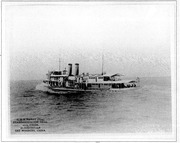| USS Panay (PR-5) | |
|---|---|
 Panay underway during the standardization trial off Woosung, China, on 30 August 1928 | |
| Career | |
| Name: | USS Panay |
| Builder: | Kiangnan Dockyard and Engineering Works, Shanghai |
| Launched: | 10 November 1927 |
| Commissioned: | 10 September 1928 |
| Fate: | Sunk by Japanese aircraft, 12 December 1937 |
| General characteristics [1][2] | |
| Type: | River gunboat |
| Displacement: | 474 long tons (482 t) |
| Length: | 191 ft (58 m) |
| Beam: | 29 ft (8.8 m) |
| Draft: | 5 ft 3 in (1.60 m) |
| Speed: | 15 knots (28 km/h; 17 mph) |
| Complement: | 59 officers and enlisted |
| Armament: |
• 2 × 3"/50 caliber gun • 8 × single .30 cal. machine guns |
The second USS Panay (PR–5) of the United States Navy was a river gunboat that served on the Yangtze Patrol in China until sunk by Japanese aircraft on 12 December 1937 on the Yangtze River.
The vessel was built by Kiangnan Dockyard and Engineering Works, Shanghai, China, and launched on 10 November 1927. She was sponsored by Mrs. Ellis S. Stone and commissioned on 10 September 1928, with Lieutenant Commander James Mackey Lewis in command.
Service history[]
Built for duty in the Asiatic Fleet on the Yangtze River, Panay had as her primary mission the protection of American lives and property frequently threatened in the disturbances that the 1920s and 1930s brought to a China struggling to modernize, create a strong central government, and later counter Japanese aggression. Throughout Panay’s service, navigation on the Yangtze was constantly menaced by bandits and soldier outlaws, and Panay and her sister ships provided protection for American shipping and nationals, as other foreign forces did for their citizens.

The Panay in 1928
Often detachments from Panay served as armed guards on American steamers plying the river. In 1931 her commanding officer, Lt. Cmdr. R. A. Dyer, reported, "Firing on gunboats and merchant ships have [sic] become so routine that any vessel traversing the Yangtze River sails with the expectation of being fired upon. Fortunately," he added, "the Chinese appear to be rather poor marksmen and the ship has, so far, not sustained any casualties in these engagements."
As the Japanese moved through South China, American gunboats evacuated most of the Embassy staff from Nanking during November 1937. Panay was assigned as station ship to guard the remaining Americans and take them off at the last moment. They came on board on 11 December and Panay moved upriver to avoid becoming involved in the fighting around the doomed capital. Three American merchant tankers sailed with her. The Japanese senior naval commander in Shanghai was informed both before and after the fact of this movement.
Sunk by the Japanese[]
On 12 December 1937, Japanese naval aircraft were ordered by their Army to attack "any and all ships" in the Yangtze above Nanking. Knowing of the presence of Panay and the merchantmen, the Imperial Japanese Navy requested verification of the order, which was received before the attack began about 13:27 that day. Although there were several large American flags flown on the ship under the command of Lt. Commander James J. Hughes, as well as one painted atop the cabin, the Japanese planes continued strafing and bombing. Panay was hit by two of the eighteen 60 kg (130 lb) bombs dropped by three Yokosuka B4Y Type-96 bombers and strafed by nine Nakajima A4N Type-95 fighters.[3] The bombing continued until the Panay sank at 15:54. Three sailors were killed, with 43 sailors and five civilian passengers wounded.
Two newsreel cameramen were present on Panay, Norman Alley (Universal News) and Eric Mayell (Movietone News), and were able to take considerable film during the attack and afterward from shore as the Panay sank in the middle of the river. The newsreels are now available online at usspanay.org (see external links below).
A formal protest was immediately lodged by the American ambassador. The Japanese government accepted responsibility, but insisted the attack was unintentional. They claimed that the pilots could not distinguish between Chinese and American flags from the distance of 300 or more yards that the pilots attacked. A large indemnity was paid (approximately $2,000,000,[4] which is equal to $33,508,274 today) on 22 April 1938 and the incident officially settled. However, further deterioration of relations between Japan and the United States continued.
Fon Huffman, the last survivor of the incident, died in 2008.[5][6]
Awards[]
See also[]
Notes[]
- ↑ Paine, Lincoln P (1997). Ships of the World. Houghton-Mifflin. pp. 385. ISBN 0-395-71556-3. LCCN 97-12872.
- ↑ Silverstone, Paul H (1966). U.S. Warships of World War II. Doubleday and Company. p. 243.
- ↑ Swanson, Harland J. (December 1967). "The Panay Incident: Prelude to Pearl Harbor". United States Naval Institute Proceedings.
- ↑ Breuer, William (1997). Unexplained Mysteries of World War II. pp. 20. ISBN 978-83-241-3265-2.
- ↑ "Obituaries in the news: Fon B. Huffman". Associated Press. International Herald Tribune. 2008-09-07. Archived from the original on 2009-07-20. http://web.archive.org/web/20090720135234/http://www.iht.com/articles/ap/2008/09/07/america/Deaths.php. Retrieved 2008-09-13.
- ↑ "Panay PR-5)". Photographic History of the U.S. Navy. NavSource Naval History. http://www.navsource.org/archives/12/1205.htm. Retrieved 2012-3-7.
This article incorporates text from the public domain Dictionary of American Naval Fighting Ships. The entry can be found here.
Further reading[]
- Koginos, Manny T. (1967). The Panay Incident: Prelude to War. Purdue University Studies.
External links[]
- USSPanay.org memorial website regarding USS Panay and Panay incident
- NavSource Online: Gunboat Photo Archive: USS Panay (PR-5), ex-PG-45
- Archive.org Universal Newsreel's 22-minute film by newsreel cameraman Norman Alley
Coordinates: 31°41′12″N 118°26′12″E / 31.68667°N 118.43667°E
The original article can be found at USS Panay (PR-5) and the edit history here.